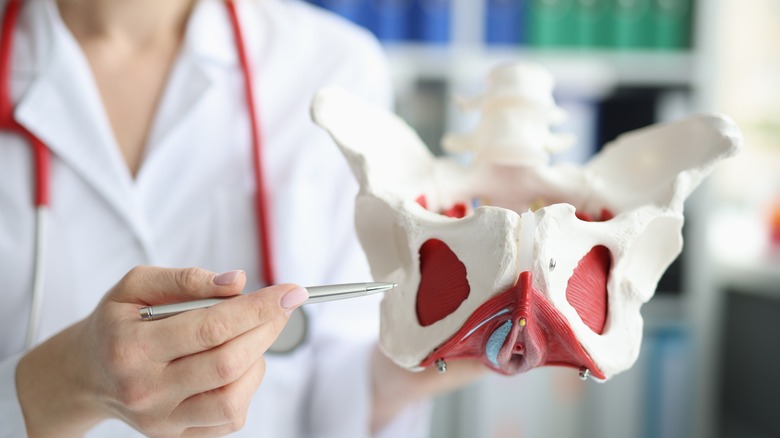New Research Finally Draws Attention To Female Sexual Health And Wellness
We may receive a commission on purchases made from links.
The medical community has a clear gender division on how they deal with sexual and reproductive wellness. As the New York Times explains, urology prioritizes sexual pleasure and orgasms for men. This is despite the fact that some doctors argue that, given that the clitoris and penis are made from the same erectile tissues, the clitoris should be a urological problem. For women and people with cycles, Dr. Rachel Ruben — a urologist and sexual health specialist — explains their sexual health "is seen as hysteria, Pandora's box, all psychosocial, not real medicine."
Talking to the Times, 33-year-old Dr. Blair Peters said his medical training didn't prepare him for the realities of actually performing phalloplasties. "When I went through medical school, we did not learn anything in particular about the clitoris beyond the fact that it exists, basically," Dr. Peters explained, adding that this attitude in training led to developing a "subconscious bias that [the clitoris] is not going to be this super-apparent structure. But it is."
When it comes to how medical research treats male and female bodies, the community acts like there aren't major biological differences or – like Ruben and Peters point out – the differences don't matter (via RAND Corporation). As a result, women's total body health and wellness issues are under-researched and underfunded. It's why Peters, a plastic surgeon that specializes in gender-affirming care, was inspired to lead a study on how many nerve endings are actually in the clitoris (via WebMD).
There's a stigma around talking about women's bodies
Jill Krapf, MD is the associate director of the Center for Vulvovaginal Disorders and told WebMD when she asks her patients about clitorial pain, it's usually the first time they've been asked. Talking to Bustle, Maria Finitizo, director of the documentary "Dilemma of Desire," said she found that most people she interviewed didn't know much about their bodies, especially their clitoris. Part of the reason, she argues, is the focus on male genitalia and sexual pleasure beginning in school health classes.
"If you don't talk about something," Finitizo said, "there's a feeling of shame around it, and that's what happens to women and girls. No one tells them they have a clitoris, and that's where the shame starts."
Most women will reach adulthood without "knowing where the clitoris is," or "how to orgasm," per Bustle. Society also believes women "have a lower capacity for sexual desire or pleasure than men" — something Bustle says many are arguing has more to do with the way our culture denies women "access to their desire and pleasure."
"The more normal it is to talk about and explore women's pleasure, the less shame women will have when getting help when they aren't experiencing pleasure," Randi Levinson, a sex, marriage, and family therapist in Los Angeles, told WebMD. "I have many ... clients who experience pain and discomfort with sex [after pregnancy] and no longer feel pleasure and are concerned that something is wrong with them."
Research about female sexual health is still new
To try and break down the stigma around female bodies, Dr. Rachel Ruben has changed the way she interacts with her patients. Instead of draping her patients legs to shield them from a pelvic exam, Ruben goes so far as to offer mirrors to patients so they can understand their bodies better.
For starters, she doesn't drape a sheet to shield patients from watching their own pelvic exam, per the New York Times. Draping perpetuates the idea that there's something that's shameful about female anatomy that needs to be hidden.
But as Dr. Blair Peters — who recently published a study updating the number of nerve endings the clitoris actually has — found out when he entered the practical aspect of his medical training, not even medical textbooks give a real understanding of what the clitoris is (via New York Times).
Peters' findings — that the clitoris has 10,000 nerve endings, which is 2,000 more than originally reported in 1976 — are partially groundbreaking because someone put time and money into the research. Historically, women's health and sexual health and wellness in particular, are underfunded and under researched areas of medicine, per WebMD.
The only other major studies were conducted when urologist Dr. Helen O'Connell discovered just in 2005 that the clitoris has both erectile and non-erectile tissues and when, in 2018, a study found that a physical examination of the clitoris is the most effective for treating adhesions or infections.
Men's health issues get more medical research funding
According to WebMD, many — including Dr. Jill Krapf —are hoping Dr. Blake Peters' research will inspire more to put time and money into studying female sexual health and wellness. A review of literature headed by Dr. Helen O'Connell, who led the ground-breaking 2005 study, found that since 1947, there have only been 11 articles on the anatomy of the clitoris and even then, the papers were in relation to genital mutilation or "restoring sensation following a clitoridectomy" (via The Guardian).
Fear and shame surrounding discussing and researching the clitoris is as big of a problem for medical professionals as it is for civilians. O'Connell, who also works as a professor, told The Guardian a colleague called a student's research on the clitoris and female orgasm "voyeurism."
But it's not just the stigma about female sexuality that blocks research from happening. As the RAND Corporation explains on their blog, science has regarded male and female anatomy as "interchangeable" in all aspects of medicine. If a disease affects one gender over another, studies show research into the disease that affects women and people with cycles is dramatically underfunded.
Fortune adds that researchers even shy away from using female mice when conducting studies, worried that a mouse's version of a menstrual cycle would create complications for their data. This same attitude applies to women and people with cycles, especially when they're at a reproductive age or pregnant.
The reason for the gender gap in medical research
"Flipper babies" are another reason why women and people with cycles are underrepresented in medical research. If you're unfamiliar with the term, we'll catch you up: from the 1940s to the 1970s, thousands of pregnant women who were prescribed thalidomide gave birth to children with what Clue calls "severe limb deformities." As a result, Clue explains the scientific community over-regulated a once under-regulated field, cutting women and people with cycles out of medical research — with the exception of hormonal birth control — for decades.
The National Institute of Health (NIH) worked with activists to have women included in clinical trials, arguing that women needed to be included, culminating in the launch of the Women's Health Initiative (WHI) in 1991. In 1993, the policy of the WHI and NIH was written into law, making it illegal to exclude women from studies for the simple fact that research might cost more. The law also stated research needed to break down findings by demographic.
Today, Clue reports there's still work to be done when it comes to including women and people with cycles in clinical trials; a study as recently as 2019 found pregnant people and geriatric women were still incredibly underrepresented in medical clinical trials. They add that when women are included in the research, the research is rarely broken down to demonstrate the differences, if any, between how women and people with cycles experience medications than men.
Barriers against women and people with cycles in medical research
Research continues to confirm the fact that biologically female and male people experience medications differently. The Conversation reports that between 1997 and 2000, eight out of ten medications had to be taken off the market in the United States because of the side effects women were experiencing. Nature adds that between 2004 and 2013, more than 2 million women and people with cycles experienced "drug-related adverse events" compared to 1.3 million people.
Maya Dusenbery, journalist and author of "Doing Harm" wrote on Quora that things won't change in the medical community until all patients aren't judged against the "male model." This is, as Dusenbery points out, despite the fact that there are now decades of research that show on a biological level, men and women experience everything from medications to diseases differently.
Dusenbery adds that the cost is as much physical as they are financial. Not only is misdiagnoses prevalent, but areas like autoimmune diseases, gynecological disorders, and chronic pain conditions in women and people with cycles just aren't a priority for researchers. When people do speak up about "atypical" symptoms — meaning they experience symptoms differently than men — is written off by the biomedical community as just being pathological, not real.
Trans and non-binary barriers in healthcare
This lack of research about female sexual health and wellness also extends to gender-affirming care and the transgender and non-binary community as a whole. Dr. Blair Peters told WebMD that his work with transgender patients was another thing that inspired his study on the clitoris. But sexual pleasure, like with women, is one piece of a completely neglected puzzle.
Whether it's physical or mental, a study in LGBT Health found that gender-affirming and inclusive care is rare in the United States. Dr. Alex Keuroghlian, director of the Fenway Institute's National LGBT Health Education Center, told NBC News that medical training doesn't currently include education about nonbinary gender identities.
For one transgender man, this ignorance almost cost him a kidney transplant. He explained to the BBC that while he's outwardly presenting male, he's biologically female — a fact that changes the way doctors would approach his care given that male and female biology are fundamentally different. But unless a patient volunteers that their biology doesn't match the checked gender on their medical forms, staff won't know. This includes reminders and invitations to gender-specific cancer screenings, like for prostate or cervical cancer in the United States.
Biological differences and hormone therapies also affect the way pharmaceuticals behave in the body. Studies have shown bodies that are female can more easily overdose because they have more sites for certain drugs to bind to. When it comes to hormone therapies, however, the BBC reports there has been little research.






